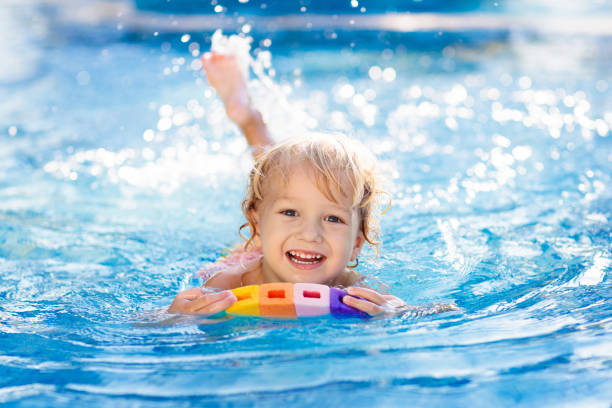Introducing young children to water at an early age can be an exciting and beneficial experience. However, ensuring their safety and comfort is essential. Shallow pool designs cater to toddlers and beginner swimmers by providing a controlled environment where they can explore water in a secure and enjoyable way. Whether designing a backyard pool or choosing a community facility, selecting the right shallow pool features can make all the difference in creating a positive experience for young swimmers.
From gentle slopes to splash pads, there are many design elements that can enhance a child’s water play while reducing risks. The goal is to create a space that fosters confidence in the water while maintaining parental peace of mind. In this article, we’ll explore some of the best shallow pool design ideas, discuss key safety considerations, and highlight features that make pools more engaging for little swimmers.
Ideal Depths for Young Swimmers
The depth of a shallow pool is one of the most crucial factors for ensuring safety and usability. For toddlers and small children, water levels should be no more than 12 to 18 inches deep. This allows them to stand and move around comfortably without the risk of submersion. Many family-friendly pools feature a “zero-entry” or beach-style slope, where the water starts at ground level and gradually deepens. This design mimics a natural shoreline and makes it easier for toddlers to wade in at their own pace.
For children who are beginning to learn how to swim, a designated shallow area with a depth of 2 to 3 feet is ideal. This provides enough space to practice basic strokes while still allowing them to touch the bottom if needed. When designing or selecting a pool for young swimmers, having distinct depth zones ensures that children of different ages and skill levels can enjoy the water safely.
Kid-Friendly Features to Enhance Safety and Fun
Beyond depth, incorporating thoughtful design features can significantly enhance a pool’s appeal for young children. A shallow pool should have slip-resistant surfaces to prevent falls, especially in areas where toddlers are prone to running. Soft, padded flooring can also provide additional protection in case of tumbles.
Interactive water features, such as gentle fountains, spray jets, or mini waterfalls, can keep young swimmers engaged while also encouraging sensory play. Shade structures, like pergolas or large umbrellas, help protect children from prolonged sun exposure, making outdoor pool time more comfortable and safe. In addition, built-in seating or submerged ledges provide resting spots where kids can sit and play without needing to leave the water.
Benefits of Splash Pads and Wading Pools
For families who want a water play area without the commitment of a full pool, splash pads and wading pools offer an excellent alternative. These shallow, interactive water spaces are designed with young children in mind, featuring small fountains, sprayers, and gentle streams of water. Unlike traditional pools, splash pads typically have little to no standing water, making them one of the safest options for toddlers.
Wading pools, on the other hand, provide a contained, shallow space where children can sit and play in the water without needing flotation devices. Many public parks and recreation centers now include these features, offering families a convenient and low-maintenance way to introduce kids to aquatic fun.
Safety First: Pool Barriers and Supervision
No matter how well-designed a shallow pool is, supervision remains the most critical safety measure. Toddlers and young children should always be within arm’s reach of a responsible adult while in or near the water. Even in water as shallow as a few inches, accidents can happen quickly.
Installing barriers, such as safety fences and self-latching gates, can prevent unsupervised access to pools. Pool covers and alarms also add an extra layer of security, particularly for backyard pools. Additionally, teaching children basic water safety rules—such as never running on wet surfaces or always waiting for an adult before entering the water—helps instill good habits early on.
Choosing the Right Pool for Your Space
When deciding on a shallow pool design, consider factors like available space, budget, and maintenance needs. In-ground pools with shallow zones or beach entries require more investment but offer long-term value and flexibility for growing children. Portable options, such as inflatable wading pools, provide a budget-friendly and temporary solution for families who want seasonal water fun without major installation costs.
For those looking to build a custom pool, working with a professional pool designer can help ensure that the final layout meets both safety standards and the unique needs of young swimmers. Features like gradual slopes, easy entry points, and play elements can transform a basic pool into an engaging and secure environment for kids.
Making Water Play Safe and Enjoyable
Shallow pools provide a wonderful way for toddlers and young swimmers to enjoy the water while building confidence and coordination. Thoughtful designs, such as zero-entry slopes, splash pads, and kid-friendly safety features, create an inviting space where children can learn and explore under supervision. By incorporating smart safety measures and choosing the right pool features, parents can ensure that water play remains a fun and worry-free experience. If you are looking for swimming pool contractors in Charlotte, there are plenty of options who can help. Whether opting for a backyard pool, community splash pad, or wading area, the key is to prioritize safety while keeping the experience engaging for little ones. With the right setup, families can enjoy countless hours of refreshing, safe, and exciting water adventures together.



































